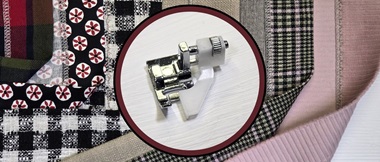
Sarah’s diary - how to insert a concealed zip
“Concealed zippers, and zippers in general, are the one thing I dread most when sewing. If I want professional finishes and grown-up looking clothes, I need to conquer this fear.”
Concealed zippers, and zippers in general, are the one thing I dread most when sewing. In fact, I’ve been so scared of zips that I’ve relied on button, tie, Velcro and popper closures for most of my sewing life.
However, I’ve realised that if I want professional finishes and grown-up looking clothes, I need to conquer this fear.
Out of all the zips to choose from, I prefer a concealed zipper (also called an invisible zipper). These are the zips where you can’t see the teeth when they are closed. Only the little zipper pull will be visible (if you’ve done it right!).
I prefer a concealed zipper because I think they add a very professional feel to whatever you’ve made. Hiding the zip looks neater and, if you’re using a patterned fabric, means there will be no break in the pattern.
With that in mind, I decided that it would be the concealed zipper I tried to master first. Then I’ll go on to perfect the rest.
My main fear when inserting zips has always been that if I do it wrong, I’ll ruin a project or expensive piece of material. Like with anything sewing related – I decided it was best to practice on a scrap piece of material first. This meant I could try again and again, without risking anything.
Whilst it’s possible to sew a concealed zip with a normal sewing foot, I found it much easier when I switched to a concealed zipper foot. The teeth of the zip are drawn into the foot, meaning you get a much closer (and straighter!) stitch – which is really important with a concealed zip.
You will need:
- An invisible/concealed zip of the correct length for you pattern
- Your pattern pieces – do not sew them together before inserting the zip
- Pins
- An invisible/concealed zipper foot
- Thread that matches your zip/garment
- Sewing machine – we’ve used the Innov-is A80
Step 1
Open your zip as far as it will go. To make it easier you can iron the zipper teeth away from the tape.
Tip: always iron on a cool heat, so you don’t melt the plastic zipper teeth. If you’re using an invisible zipper foot, you won’t need to iron the teeth out.

Step 2
Finish off the edges of the material you’ll be using, but don’t sew together. Using tailor’s chalk or washable pen, mark on the right side of your fabric, where your zip will be placed. Also draw in the seam allowance along the top of the fabric.
Step 3
Place the right side of zip tape against the right side of the material and pin in place. Do this for left hand pattern piece/left hand side of the zip only. We’ll sew left side first, then pin and sew the remaining right side.
Tip: always pin with the pin heads towards you (facing away from the needle), so you can easily pull the pins out as you sew. You’ll notice that I’ve pinned the wrong way in this video. Beginner’s mistake!

Step 4
Change your machine foot to the invisible zipper foot, following your machine’s instructions. Starting from the top of your zip, place the zipper teeth into the left-hand groove on the invisible zipper foot, so that your sewing needle is on the right-hand side of the teeth. Stitch all the way to the bottom of the zip.
Tip: like with all sewing, backstitch the first and last few stitches to secure.

Step 5
Like we did with the left-hand side of the pattern/zip, pin the right side of the right-hand zip tape to the right side of the pattern material.
Tip: make sure your zip isn’t twisted, or it won’t close.

Step 6
Insert the zipper teeth into the right-hand groove on the invisible zip and sew from top to bottom.
Step 7
When your invisible zip is sewn in, continue with the rest of your garment.
What did I learn?
- Correct measurement is vital – I like to ‘eyeball’ a lot of my seam allowances, but you need to be exact for a concealed zip. Otherwise it won’t line up and can cause your garment to buckle in strange places.
- Make sure your zip isn’t twisted and that each side of the zip is facing the right way, or you zip won’t work.
- Go slowly and practice as many times as you need to. Soon you’ll be getting it right every time.
Which zipper should I attempt next?




